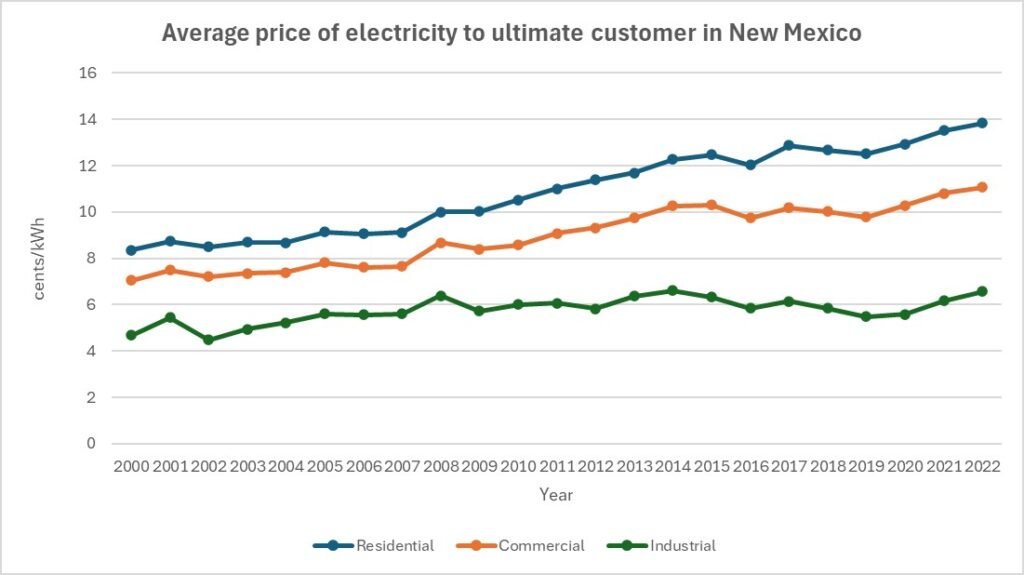Energy Landscape Report 2025
A Comprehensive Review of New Mexico’s Energy Sector, Trends, and Future Pathways
Download Full Report
Key Highlights
1. New Mexico’s Energy Shift
Wind power now leads electricity generation (38%), followed by natural gas (36%).
Natural Gas average capacity factor continues to increase (from 45% to 70%), ensuring grid stability, while wind (-40%) and solar (-30%) stay steady.
The industrial sector consumes the most electricity, while natural gas remains the dominant energy source for power generation, industrial operations, and residential use across the state.
2. Oil & Gas Economic Impact
NM is the Top 2 oil producer in the U.S. and Top 10 gas producer in 2023.
Oil and gas revenues contributed 34.5% of the state’s total revenue in 2023.
3. Untapped Geothermal Potential
New Mexico ranks 6th in the U.S. for geothermal resources, yet it remains largely underdeveloped.
4. Grid Modernization & Energy Exports
Electricity costs continue to rise, while grid reliability declines, highlighting the need for infrastructure upgrades.
The state’s strategic resources and location can allow it to balance regional energy supply.
5. Carbon Management
Coal-related emissions are declining, but still, with oil and gas, remain major contributors to greenhouse gases.
Carbon capture, utilization, and storage (CCUS) projects are critical for a just energy transition.
6. Workforce & Economic Diversification
As coal and fossil fuel sectors decline, retraining programs are essential to transition workers into geothermal, CCUS, and advanced energy industries.
Cite This Work
When citing this report, please also cite the underlying data sources. This report can be cited as:
Jean-Lucien Fonquergne, Sandrine Bayle, Miguel Lopez-Ferber, Ewen Fraval, Hector Bonnet, Kyllian Chomet, and Gabriel Frimpong (2025) – New Mexico Energy Landscape: Overview and Analysis 2025. Published online by the Petroleum Recovery Research Center and the New Mexico Energy Initiatives at New Mexico Institute of Mining and Technology: https://nm-secm.org/new-mexico-energy-landscape-overview-and-analysis-2025.
Project Background
Find out more about the project background here: Link
Data Source
Unless stated otherwise, all data is sourced from the State Energy Data System (SEDS), the U.S. Energy Information Administration’s (EIA) comprehensive database for state energy statistics. The link for the data source is: https://www.eia.gov/state/seds/
Contact & Get Involved
Join us in shaping New Mexico’s energy future!
Whether in industry, research, or policy, collaborate on cutting-edge projects, drive innovation, and support a sustainable transition for New Mexico and beyond.
Project lead contact: jean-lucien.fonquergne@nmt.edu
Disclaimer
The information presented is based on publicly available data, research, and analysis conducted by the authors. While every effort has been made to ensure accuracy and reliability, the authors and affiliated institutions do not guarantee the absolute correctness of the information provided. Any conclusions or interpretations presented reflect the perspectives of the authors and do not necessarily represent the official positions of NMT or IMT Alès. The report is intended for informational purposes only and can provide insights; however, the authors and affiliated institutions are not responsible for any decisions made based on its content. The authors and affiliated institutions shall not be held responsible for any errors, omissions, or consequences arising from the use of this report. Readers are encouraged to verify information independently and consult appropriate experts before making decisions based on the content of this document. For further inquiries, please contact:










